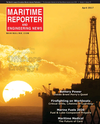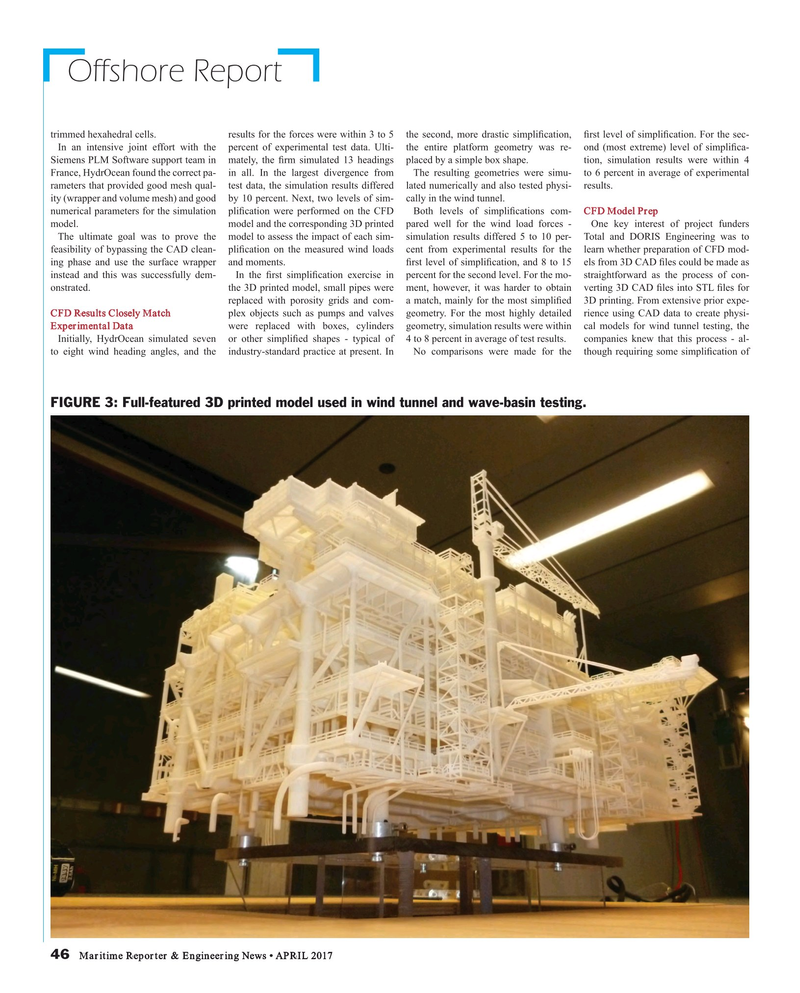
Page 46: of Maritime Reporter Magazine (April 2017)
The Offshore Annual
Read this page in Pdf, Flash or Html5 edition of April 2017 Maritime Reporter Magazine
Offshore Report trimmed hexahedral cells. results for the forces were within 3 to 5 the second, more drastic simpli? cation, ? rst level of simpli? cation. For the sec-
In an intensive joint effort with the percent of experimental test data. Ulti- the entire platform geometry was re- ond (most extreme) level of simpli? ca-
Siemens PLM Software support team in mately, the ? rm simulated 13 headings placed by a simple box shape. tion, simulation results were within 4
France, HydrOcean found the correct pa- in all. In the largest divergence from The resulting geometries were simu- to 6 percent in average of experimental rameters that provided good mesh qual- test data, the simulation results differed lated numerically and also tested physi- results.
ity (wrapper and volume mesh) and good by 10 percent. Next, two levels of sim- cally in the wind tunnel.
numerical parameters for the simulation pli? cation were performed on the CFD Both levels of simpli? cations com- CFD Model Prep model. model and the corresponding 3D printed pared well for the wind load forces - One key interest of project funders
The ultimate goal was to prove the model to assess the impact of each sim- simulation results differed 5 to 10 per- Total and DORIS Engineering was to feasibility of bypassing the CAD clean- pli? cation on the measured wind loads cent from experimental results for the learn whether preparation of CFD mod- ing phase and use the surface wrapper and moments. ? rst level of simpli? cation, and 8 to 15 els from 3D CAD ? les could be made as instead and this was successfully dem- In the ? rst simpli? cation exercise in percent for the second level. For the mo- straightforward as the process of con- onstrated. the 3D printed model, small pipes were ment, however, it was harder to obtain verting 3D CAD ? les into STL ? les for replaced with porosity grids and com- a match, mainly for the most simpli? ed 3D printing. From extensive prior expe-
CFD Results Closely Match plex objects such as pumps and valves geometry. For the most highly detailed rience using CAD data to create physi-
Experimental Data were replaced with boxes, cylinders geometry, simulation results were within cal models for wind tunnel testing, the
Initially, HydrOcean simulated seven or other simpli? ed shapes - typical of 4 to 8 percent in average of test results. companies knew that this process - al- to eight wind heading angles, and the industry-standard practice at present. In No comparisons were made for the though requiring some simpli? cation of
FIGURE 3: Full-featured 3D printed model used in wind tunnel and wave-basin testing.
46 Maritime Reporter & Engineering News • APRIL 2017
MR #4 (42-49).indd 46 MR #4 (42-49).indd 46 4/4/2017 1:34:37 PM4/4/2017 1:34:37 PM

 45
45

 47
47
